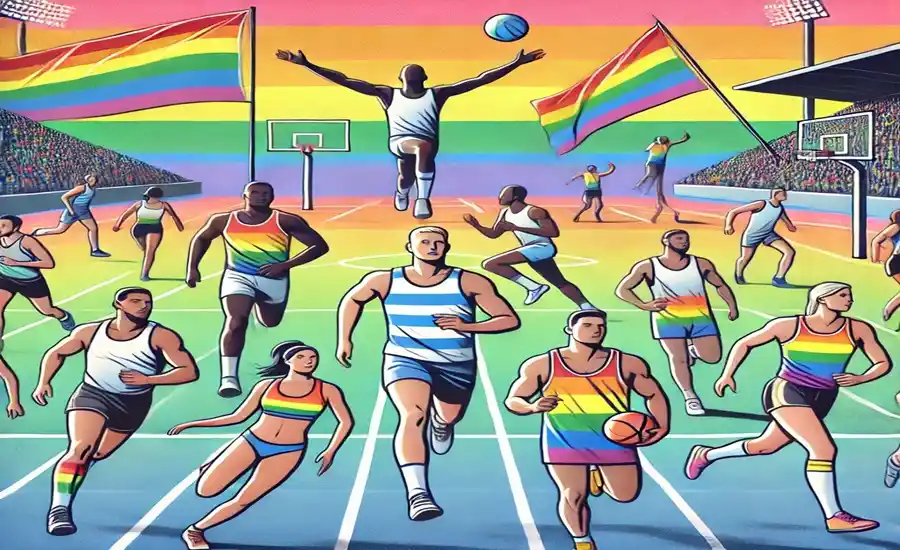
Sports can be an amazing way to connect with others, build community, and stay active. However, transgender and gender diverse individuals often face significant barriers in accessing and participating in sports. Understanding these challenges and implementing inclusive practices is crucial for creating a welcoming environment for all athletes.
Gender identity is a deeply personal aspect of who we are, and using the correct terms can foster respect and inclusion. By understanding and using these terms correctly, we can help create an environment where everyone feels seen and valued.
Transgender and gender diverse individuals face unique challenges in the sports world. Many sporting clubs only have teams for women and men, leaving non-binary and other gender diverse athletes without a place to participate. This exclusion can be detrimental to their physical and mental well-being. The lack of representation and acceptance can lead to feelings of isolation and alienation, further exacerbating the challenges faced by these individuals.
Assumptions and Stereotypes: There are many assumptions about what people’s bodies will be like, often based on outdated stereotypes about hormones, height, body types, and skills. These stereotypes ignore the natural variation in everyone’s hormone levels and physical abilities, including those of cisgender people. For example, assuming that all men are inherently stronger or faster than all women fails to recognize the individual differences and the impact of training, genetics, and other factors. This oversimplification not only undermines the abilities of athletes but also perpetuates harmful gender norms.
Social Barriers: Transphobic comments, gendered insults, and lack of privacy respect can create a hostile environment for transgender athletes. Many trans individuals are forced to disclose personal details about their gender and medical history, which is inappropriate and invasive. This can lead to a culture of fear and discomfort, deterring many from participating in sports altogether. Furthermore, the lack of gender-neutral facilities like locker rooms and restrooms adds another layer of difficulty for transgender athletes. The psychological toll of navigating these spaces often goes unnoticed but significantly impacts their overall well-being.
To make sports more inclusive for transgender and gender diverse people, consider implementing the following practices:
Creating a truly inclusive environment goes beyond policy-making. It requires a commitment to understanding and valuing the experiences of transgender and gender diverse individuals. By involving them at all levels, from decision-making to day-to-day interactions, we can create a sports culture that is genuinely inclusive.
Inclusion is not optional. It’s essential to create a sports environment where everyone feels welcome. If someone in your club is excluding others, take them aside, educate them, or reach out to trans-led organizations for support. Make your club a welcoming place for everyone from the start.
Advocacy can be powerful but should not be compulsory for every trans person. Be proactive in creating an inclusive environment so transgender individuals see your club as welcoming and choose to join. This can involve partnering with local LGBTQ+ organizations, participating in pride events, and publicly supporting trans rights. Advocates should strive to create spaces where transgender individuals feel seen, heard, and valued.
It's important to remember that being an advocate means more than just creating policies; it involves active engagement and continuous learning. Advocacy should be a collaborative effort that includes listening to the voices of transgender individuals and working together to make sports more inclusive. This might involve attending workshops, reading literature on gender diversity, and participating in discussions that challenge existing norms and practices.
Advocates can also play a critical role in challenging and changing the social attitudes that create barriers for transgender athletes. This includes speaking out against transphobia, supporting inclusive language, and promoting stories of transgender athletes to highlight their contributions and successes. By doing so, we can help to dismantle stereotypes and create a more accepting and inclusive sports culture.
Additionally, it's important for advocates to recognize that each transgender individual's experience is unique. There is no one-size-fits-all approach to inclusion. Listening to and respecting the specific needs and preferences of each transgender athlete is crucial for creating a supportive environment.
To further illustrate the importance of inclusive sports environments, let's look at some case studies and examples of successful inclusion practices:
Chris Mosier is a trailblazing transgender athlete who has made significant strides in advocating for the inclusion of transgender individuals in sports. As the first openly transgender man to make a U.S. national team, Chris has used his platform to raise awareness and promote inclusive policies. His advocacy work has led to important changes in the policies of major sports organizations, including the International Olympic Committee (IOC). Chris's story highlights the impact that one individual's advocacy can have on the broader sports community.
Mack Beggs is another example of a transgender athlete who has faced significant challenges and triumphed. As a high school wrestler in Texas, Mack won two state championships while transitioning from female to male. Despite facing criticism and resistance, Mack's determination and success brought attention to the need for inclusive policies in high school sports. His story underscores the importance of perseverance and the positive impact that inclusive sports environments can have on transgender athletes.
In recent years, some sports leagues have taken proactive steps to create gender-neutral teams and leagues. For instance, the New York Ramblers, a soccer club in New York City, established a gender-neutral league to ensure that all players, regardless of their gender identity, have the opportunity to participate. This approach has not only provided a space for non-binary and gender diverse athletes but has also fostered a more inclusive and accepting sports community. The success of the New York Ramblers' gender-neutral league serves as a model for other sports organizations looking to implement similar practices.
Educational initiatives play a critical role in fostering inclusivity in sports. Organizations like Athlete Ally and You Can Play work to educate athletes, coaches, and sports organizations about LGBTQ+ inclusion. These initiatives often include workshops, training sessions, and resources that help to raise awareness and promote understanding of gender diversity. By equipping sports communities with the knowledge and tools to support transgender athletes, educational initiatives contribute to creating a more inclusive sports culture.
Policy changes are essential for creating inclusive sports environments. The National Collegiate Athletic Association (NCAA) has implemented guidelines that allow transgender athletes to compete in accordance with their gender identity. These guidelines provide a framework for colleges and universities to support transgender athletes and ensure fair competition. The NCAA's policy changes demonstrate the importance of institutional support and the positive impact that inclusive policies can have on transgender athletes' participation in sports.
To implement inclusive practices effectively, sports organizations can follow these practical steps:
Implementing inclusive practices is an ongoing process that requires commitment and dedication. By following these practical steps, sports organizations can create environments where transgender athletes feel safe, respected, and empowered to participate fully in sports.
Creating inclusive sports environments for transgender and gender diverse individuals is crucial for their well-being and participation in sports. By implementing inclusive policies, educating staff and athletes, and fostering a supportive environment, we can ensure that everyone has the opportunity to enjoy the benefits of sports.
Sports offer numerous physical, mental, and social benefits. Ensuring that transgender and gender diverse individuals can participate fully and comfortably in sports is not just about fairness, but about recognizing and celebrating the diversity of all athletes. Together, we can create a sports culture that values inclusion, respect, and equality for everyone. By championing inclusivity, we not only enrich the sports experience but also contribute to a more equitable society where everyone can thrive.
In conclusion, creating an inclusive sports environment requires a multifaceted approach. It involves policy changes, education, and active advocacy. It also requires a commitment to listening to and valuing the experiences of transgender and gender diverse individuals. By working together, we can create a sports culture that is truly inclusive and welcoming for all.
The journey towards inclusivity is ongoing, and it involves continuous effort and dedication. It's about more than just allowing transgender individuals to participate in sports; it's about creating an environment where they feel valued and respected. By fostering an inclusive sports culture, we can help to ensure that all athletes, regardless of their gender identity, have the opportunity to thrive and succeed.
Together, we can make a difference. By championing the rights and inclusion of transgender athletes, we can help to create a world where everyone is free to participate in sports and enjoy the many benefits it has to offer. Let's work together to create a sports culture that is inclusive, respectful, and welcoming for all.
To support the inclusion of transgender athletes in sports, consider taking the following actions:
By taking these actions, we can help to create a sports culture that is truly inclusive and welcoming for all athletes. Together, we can make a positive impact and ensure that everyone has the opportunity to participate in sports and enjoy its many benefits.
For more information and resources on supporting transgender athletes, consider exploring the following organizations:
These organizations provide valuable resources, support, and advocacy for transgender athletes and can help guide efforts to create more inclusive sports environments.
The inclusion of transgender athletes in sports is a crucial aspect of promoting equality and respect for all individuals. By understanding the challenges faced by transgender athletes and taking proactive steps to create inclusive environments, we can help to ensure that everyone has the opportunity to participate fully in sports and enjoy its many benefits. Let's work together to create a sports culture that values inclusion, respect, and equality for everyone.
Thank you for taking the time to read this article. Your commitment to supporting transgender athletes and promoting inclusivity in sports is greatly appreciated. Together, we can make a positive impact and create a world where everyone is free to participate in sports and be their true selves.

Lorem ipsum dolor sit amet, consectetur adipiscing elit. Integer bibendum augue eget orci tincidunt, eget gravida arcu mollis. Nulla facilisi. Proin vel erat nec sapien venenatis cursus. Proin euismod, lectus ac elementum gravida, neque lacus interdum ex, id varius lectus lacus at orci.

Lorem ipsum dolor sit amet, consectetur adipiscing elit. Integer bibendum augue eget orci tincidunt, eget gravida arcu mollis. Nulla facilisi. Proin vel erat nec sapien venenatis cursus. Proin euismod, lectus ac elementum gravida, neque lacus interdum ex, id varius lectus lacus at orci.